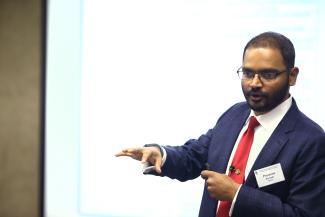
Companies that make substantial investments in information technology (IT) hardware and software will be bombarded on a regular basis by new products and innovations. They therefore need to have an effective governance system in place that will help them to manage the opportunities and potential risks.
Professor Prasanna Karhade has been studying the governance of IT portfolios, with particular focus on a multinational conglomerate which invests hundreds of millions of dollars in IT each year.
“When it comes to governance and IT portfolios you need to consider three things: whether you have a decision-making system that instils some accountability on the use of IT, whether you have a cohesive strategy for investing in IT, and how you prioritise initiatives for investment,” he said.
A conservative company operating in a stable, predictable environment will have different priorities from an innovative firm that is looking to grow fast and operates in a turbulent, dynamic environment. Therefore, one size does not fit all in IT portfolio governance. But there are a few guidelines that can be applied generally.
First, managers should be aware of the decision rationales for approving or rejecting projects, and these rationales should be communicated within the firm. Second, decision rules should be applied as consistently as possible. And third, executives should ask a lot of questions related to these rules before they make decisions.
Conservative companies will likely be much more consistent in applying rules, have a high degree of communicability, and focus on risk assessment and mitigation. Innovators, on the other hand, may not be able to apply their rules as consistently due to the changing environment and may have difficulty communicating their rationales in a compact manner. Their focus will be more on the benefits of an investment.
These differences were borne out in work Professor Karhade did on the software portfolio of the multinational conglomerate. The company had drafted 15 attributes for investment under three headings – describing benefits, assessing risk, and mitigating risk – and he stacked them up against actual decisions made to see how they were implemented within the firm.
Not all attributes were pertinent to all decisions or even all branches of the multinational conglomerate. A conservative branch within the company relied mostly on five attributes, four of which pertained to risk assessment and mitigation. An innovative unit, however, was more focused on the benefits of the investment.
Professor Karhade advised companies to take six steps in managing their IT portfolios. First, identify initiatives in distinct portfolios such as hardware and software.
Second, gather data including that for projects that were rejected because much could be learned from these decisions.
Third, define the decision-making scheme, whether it is a straightforward yes-no binary system or one that involves more complex considerations.
Fourth, develop a repository of rules and involve the CEO and CIO in the process.
Fifth, take care when applying these rules. “When you’re applying rules, you’re dealing with different politics within the company. If you make all your rules salient to everyone, then they will try to game the system and come up with proposals that meet the rules. It is going to be tricky but it is still important to know the rules because then you can make some educated exceptions to those rules,” he said.
Finally, firms should manage portfolio life cycles. Annual reviews of the outcome of initiatives can be useful, although Professor Karhade advised that these be conducted sensitively. “If managers come up with grandiose projects that are more likely to fail, they should not be punished too harshly for that. At the other end of the spectrum, you don’t want all your managers thinking very conservatively – you want them to take some intelligent risks. Your aim should be to try to find this happy balance,” he said.
Professor Prasanne Karhade of the Business School’s Department of ISOM was speaking at the Business Insights luncheon in February 2015.

